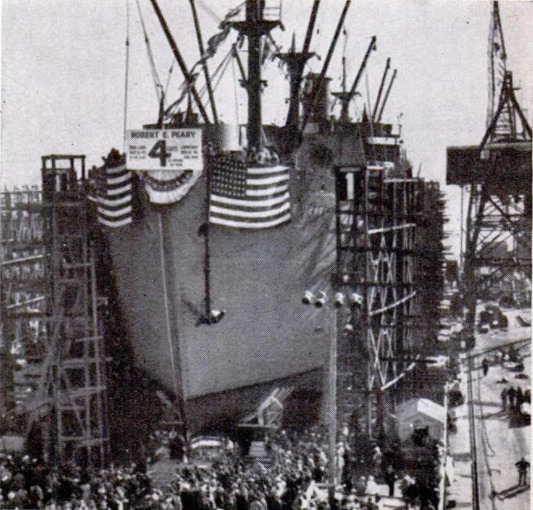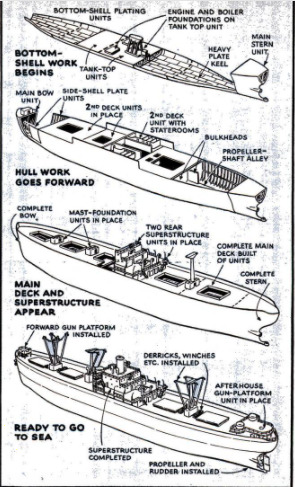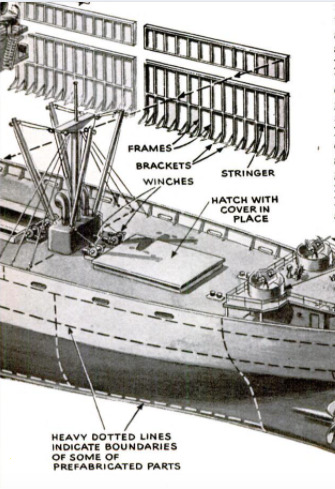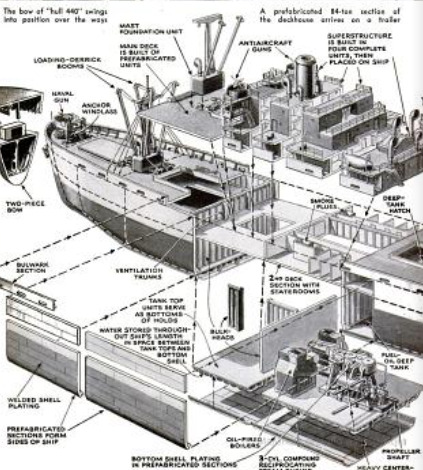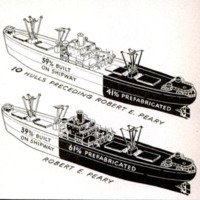-
Title (Dublin Core)
-
Kaiser builds a new ship
-
Article Title and/or Image Caption (Dublin Core)
-
Title: What happens when Kaiser builds a ship
-
Subtitle: A jigsaw puzzle of steel with a quarter of a million pieces and 97 prefabricated sections, form a new vessel fro victory
-
extracted text (Extract Text)
-
WHEN the 10,500-ton Robert E.
peary on November 12, 1942,
slid down way No. 1 of Henry
J. Kaiser's Richmond shipyard after
being on the ways only four days, 15
hours, and 26 minutes, it did more
than set a world's record in speedy
shipbuilding. It set records in pre-
fabrication, labor-management co-op-
eration, and Yankee ingenuity in getting a |
fast job done well. Prior to the launching of
the Peary—called “Hull 440” while in con-
struction—the Richmond builders had been
averaging a keel-to-launching time of 57 days |
per hull, which they had subsequently lowered
to 42 days. They were feeling pretty proud
of themselves when word came that the Ore-
gon shipyards had launched a hull in 10 days
and had delivered 11 ships that same month. |
Kaiser's engineers hitched up their pants and
decided they’d do something about that. They
started by asking questions of welders, rig- |
gers, pipefitters, shipfitters, draftsmen, and
machinists—and the answers came back in
hundreds of ideas—rigs, jigs, gadgets, devices, |
and suggestions which showed that the workers |
not only knew their business but
that they were willing to work for a
new record. Take the welders, for
instance. When volunteers were
called for, a dozen women welders |
threatened to quit unless they were
included. They and dozens of men |
went to work with arcs blazing, and
by the time the hull was laid, 152,000
feet of weld had been completed on
the assembly tables—50,000 more
than on previous hulls—and only
57,800 remained to be welded on the
ways. Riggers then found they had
fewer lifts to make because prefabri-
cated sections were more complete.
So they set about saving hundreds of
man-hours by moving 84-ton deck-
houses and 70-ton bulkheads nearer |
the ways to have them right at hand
the instant they were needed. Pre-
fabrication reached such a high that
when the main unit of the 440's
deckhouse was swung into place with
giant cranes, it was complete down
to electric clocks and inkwells.
Approximately 250,000 individual
items went into the building of Hull
440. But by the time the prefabrica-
tion boys had finished their work on
the assembly tables, only 97 giant
sections needed to be lifted on to the
ways. The huge keel called for the
laying of merely six main sections.
Eighty percent of the 23,005 rivets
used were driven home on the as-
sembly tables. And on the bilge and
forepeak, 18 gangs of five men each
worked ‘round the clock to finish
their job before the keel was laid.
The marine machinists did their
job, too. They had the 135-ton en-
gine in place 12 hours after the keel
was down, and in another 36 hours
they had it ready to run.
Before shipyard workers can do
their job, they must have the mate-
rials—and they must have ‘em when
they need ’em. To insure that they
get them, Kaiser employs a staff of
what he calls expediters. Ingenious,
resourceful, and aggressive, these
energetic men scamper all over the
country, busting bottlenecks wide
open as they run. It is this kind of
teamwork that has reduced ship-
building time from years to days.
-
Contributor (Dublin Core)
-
Stewart Rouse (Illustrator)
-
Language (Dublin Core)
-
eng
-
Date Issued (Dublin Core)
-
1943-03
-
pages (Bibliographic Ontology)
-
64-66
-
Rights (Dublin Core)
-
Public Domain (Google Digitized)
-
Archived by (Dublin Core)
-
Matteo Ridolfi
-
Marco Bortolami (editor)
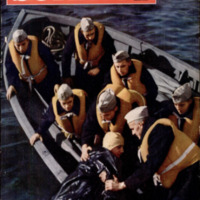 Popular Science Monthly, v. 142, n. 3, 1943
Popular Science Monthly, v. 142, n. 3, 1943


